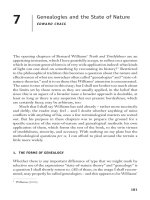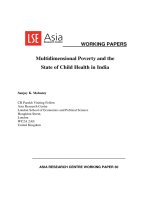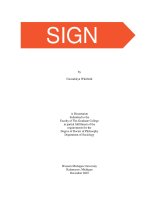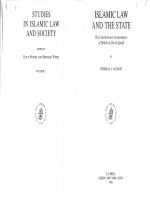- Trang chủ >>
- Khoa Học Tự Nhiên >>
- Vật lý
social movements identity culture and the state jun 2002
Bạn đang xem bản rút gọn của tài liệu. Xem và tải ngay bản đầy đủ của tài liệu tại đây (1.61 MB, 383 trang )
Social Movements:
Identity, Culture, and
the State
David S. Meyer
Nancy Whittier
Belinda Robnett,
Editors
OXFORD UNIVERSITY PRESS
Social Movements
This page intentionally left blank
SOCIAL MOVEMENTS
Identity, Culture, and the State
Edited by David S. Meyer,
Nancy Whittier, & Belinda Robnett
1
2002
3
Oxford New York
Auckland Bangkok Buenos Aires Cape Town Chennai
Dar es Salaam Delhi Hong Kong Istanbul Karachi Kolkata
Kuala Lumpur Madrid Melbourne Mexico City Mumbai Nairobi
São Paulo Shanghai Singapore Taipei Tokyo Toronto
and an associated company in Berlin
Copyright © 2002 by Oxford University Press, Inc.
Published by Oxford University Press, Inc.
198 Madison Avenue, New York, New York 10016
www.oup.com
Oxford is a registered trademark of Oxford University Press
All rights reserved. No part of this publication may be reproduced,
stored in a retrieval system, or transmitted, in any form or by any means,
electronic, mechanical, photocopying, recording, or otherwise,
without the prior permission of Oxford University Press.
Library of Congress Cataloging-in-Publication Data
Social movements : identity, culture, and the state / edited by David S. Meyer,
Nancy Whittier, Belinda Robnett.
p. cm.
Includes bibliographical references and index.
ISBN 0-19-514355-8; ISBN 0-19-514356-6 (pbk.)
1. Social movements. I. Meyer, David S. II. Whittier, Nancy, 1966–
III. Robnett, Belinda, 1956–
HM881 .S63 2001
303.48'4–dc21 2001036973
98 76 5 4 3 2 1
Printed in the United States of America
on acid-free paper
To Zena,
Jonah,
David and Jonah
This page intentionally left blank
Acknowledgments
We are grateful to a number of people and institutions for their help in this
project. The workshop that led to this volume was partly supported by a small
grant from the American Sociological Association/National Science Founda-
tion Fund for the Advancement of the Discipline and was organized under
the auspices of the American Sociological Association Section on Collec-
tive Behavior and Social Movements. Manisha Desai, Rob Kleidman, Paul
Lichterman, and Jo Reger helped organize that workshop. We appreciate the
excellent services provided by Teresa Brown, Coordinator of the UC-Davis
Conference and Event Services, without whom the workshop could not have
taken place. We had research and clerical assistance from Meg Chilton and
Morgan Lynn at Smith College, supported by the Smith College Committee
on Faculty Compensation and Development, and from Jeanne Batalova
Treigherman and Yuki Kato at the University of California–Irvine. We are
also grateful to the Center for the Study of Democracy, at the University of
California–Irvine, which provided help when it was most needed. Finally, we
appreciate the efforts of the contributors, many of whom not only wrote their
own chapters but provided useful comments that helped to shape the book.
This page intentionally left blank
Contents
Contributors xiii
part i. introduction
1. Opportunities and Identities: Bridge-Building in the Study
of Social Movements 3
David S. Meyer
part ii. states and policies
Introduction to Part II 25
2. State Repression and Democracy Protest in Three Southeast
Asian Countries 28
Vincent Boudreau
3. Mobilization on the South African Gold Mines 47
T. Dunbar Moodie
4. Multiple Mediations: The State and the Women’s Movements
in India 66
Manisha Desai
5. The Contradictions of Gay Ethnicity: Forging Identity
in Vermont 85
Mary Bernstein
6. Creating Social Change: Lessons from the Civil
Rights Movement 105
Kenneth T. Andrews
x Contents
part iii. organizations and strategies
Introduction to Part III 121
7. The “Meso” in Social Movement Research 124
Suzanne Staggenborg
8. Strategizing and the Sense of Context: Reflections on the
First Two Weeks of the Liverpool Docks Lockout,
September–October 1995 140
Colin Barker and Michael Lavalette
9. Factions and the Continuity of Political Challengers 157
Mildred A. Schwartz
10. More Than One Feminism: Organizational Structure and the
Construction of Collective Identity
171
Jo Reger
11. The Development of Individual Identity and Consciousness among
Movements of the Left and Right
185
Rebecca E. Klatch
part iv. collective identities, discourse,
and culture
Introduction to Part IV 205
12. Toward a More Dialogic Analysis of Social
Movement Culture
208
Marc W. Steinberg
13. Materialist Feminist Discourse Analysis and Social
Movement Research: Mapping the Changing Context
for “Community Control”
226
Nancy A. Naples
14. From the “Beloved Community” to “Family Values”: Religious
Language, Symbolic Repertoires, and Democratic Culture
247
Rhys H. Williams
15. External Political Change, Collective Identities, and Participation
in Social Movement Organizations
266
Belinda Robnett
xi Contents
part v. conclusion
16. Meaning and Structure in Social Movements 289
Nancy Whittier
References 309
Index 347
This page intentionally left blank
Contributors
Kenneth T. Andrews is assistant professor of sociology at Harvard Uni-
versity. His research examines questions about the impacts of social move-
ments. He is completing a book, “Freedom Is a Constant
Struggle”: The
Dynamics and Consequences of the Mississippi Civil Rights Movement, that
traces the development of the movement and its impact on electoral politics,
educational institutions, and social policies. He is beginning a project on
contemporary environmental politics in the United States.
Colin Barker teaches in the sociology department at Manchester Metro-
politan University. An active socialist, he organizes the annual “Alternative
Futures & Popular Protest” conference series each Easter and convenes the
British Sociological Association Study Group on Protest and Social Move-
ments. Publications include Festival of the Oppressed: Solidarity, Reform and
Revolution in Poland (1986) and Revolutionary Rehearsals (1987).
Mary Bernstein is assistant professor of s
ociology at the University of Con-
necticut. Her research, which has appeared in the American Journal of Sociol-
ogy and the American Sociological Review, focuses on sexuality, social
movements, and the law. Her recently published edited book Queer Families,
Queer Politics, Challenging Culture and the State (Columbia University Press)
connects the microdynamics of gender, sexuality, and the family with the
macrodynamics of politics and the law. Currently, she is completing a book
on lesbian, gay, bisexual, and transgender political strategies and legal change.
Vincent Boudreau is associate professor of political science at the City Col-
lege of New York. He is the author of At the Margins of the Movement:
Grassroots and Cadre in a Philippine Socialist Network and has written more
generally about political contention in Southeast Asia, especially in the Phil-
xiii
xiv Contributors
ippines. His current research investigates how established patterns of repres-
sion and state violence shape political contention, but this project is part of
a larger program to broaden and deepen the theoretically informed study of
social movements outside of the global north.
Manisha Desai is associate professor of sociology and chair of the Depart-
ment of Anthropology and Sociology at Hobart and William Smith Colleges
in Geneva, New York. Her research and teaching have focused primarily on
social movements in India, international women’s movements, international
development, women and globalization, feminist theory, and human rights. She
is currently completing an edited book with Nancy Naples, Women in Glo-
balization from Below: Multiple Sites of Women’s Activism (forthcoming,
Routledge), and starting work on an edited book, Globalization and Human
Rights: Women’s Interventions in Asia, to be published by Greenwood.
Rebecca E. Klatch is professor of sociology at the University of Califor-
nia–San Diego. She is author of Women of the New Right (Temple Univer-
sity Press, 1987) and A Generation Divided: The New Left, The New Right,
and the 1960s (University of California Press, 1999), as well as numerous
articles on social movements, gender, and family politics.
Michael Lavalette teaches in the sociology, social policy and social work
studies department at Liverpool University. He writes on child labor, Marx-
ism and social policy, and collective action. Among his publications on so-
cial movements are Leadership and Social Movements (edited with Colin
Barker and Alan Johnson, forthcoming), Solidarity on the Waterfront (1996),
and Class Struggle and Social Welfare (2000). He is an active member of the
Socialist Workers Party in Britain.
David S. Meyer is associate professor of sociology at the University of Cali-
fornia, Irvine. In addition to numerous articles on social movements, he is
author of A Winter of Discontent: The Nuclear Freeze and American Poli-
tics, coeditor, with Sidney Tarrow, of The Social Movement Society
, and
coeditor, with Thomas Rochon, of Coalitions and Political Movements. He
is most interested in the connections among social movements, public policy,
and institutional politics.
T. Dunbar Moodie is professor of sociology in the Department of Anthro-
pology and Sociology at Hobart and William Smith Colleges. He is the author
of The Rise of Afrikanerdom and Going for Gold, as well as numerous articles.
His early work dealt with the origins of the Afrikaner ethnic movement and its
impact on the development of apartheid ideology and the attainment of politi-
xv Contributors
cal power. He now writes mostly about black South African gold miners, with
special attention to modes of survival and resistance in their everyday lives in
the context of wider South African economic, political, and social changes.
Nancy A. Naples is associate professor of sociology and women’s studies
at the University of California–Irvine. She has a Ph.D. in sociology from the
Graduate Center and an M.S.W. from Hunter College, City University of New
York. Her research emphasizes women’s community activism; the intersec-
tion between race, class, gender, sexuality, and region; and the contradictory
role of the state for women’s social and political citizenship. Much of her
scholarship focuses on bridging the so-called gap between theory and prac-
tice, as well as explicating a feminist epistemology of activist research. She is
author of Grassroots Warriors: Activist Mothering, Community Work, and
the War on Poverty and editor of Community Activism and Feminist Poli-
tics: Organizing across Race, Class, and Gender, both published by Routledge
in 1998. She is coeditor of Women’s Activism and Globalization: Linking
Grassroots Movements and Transnational Politics with Manisha Desai, forth-
coming from Routledge, 2001.
Jo Reger is an assistant professor at Oakland University whose work ex-
amines gender and social movements. Her current research focuses on the
U.S. women’s movement and the influence of community and identity on or-
ganizational continuity.
Belinda Robnett is associate professor of sociology and director of Afri-
can American studies at the University of California, Irvine. Her work has
appeared in the American Journal of Sociology and other venues. She is the
author of How Long? How Long? African-American Women in the Struggle
for Civil Rights (Oxford University Press, 1997), which received the Ameri-
can Sociological Association Race, Gender, and Class Section and Sex and
Gender Section Honorable Mention Book Award in 2000. She is currently
working on a new book manuscript entitled
Our Struggle for Unity: African-
Americans in the Age of Identity Politics.
Mildred A. Schwartz is a visiting scholar in the Department of Sociology
at New York University and Professor Emeritus of sociology and political
science at the University of Illinois at Chicago. Her chapter is part of an on-
going examination of political challengers in western Canada and the United
States. She has additional research under way on transnational ties that have
developed in Canada, the United States, and Mexico as a result of the North
American Free Trade Agreement. She is also collaborating with three col-
leagues in preparing a handbook of political sociology.
xvi Contributors
Suzanne Staggenborg is professor of sociology at McGill University. Her
work includes The Pro-Choice Movement: Organization and Activism in the
Abortion Conflict (Oxford University Press, 1991), Gender, Family, and
Social Movements (Pine Forge Press, 1998), and a number of articles about
abortion politics and social movements in the United States and Canada.
Marc W. Steinberg teaches sociology at Smith College. He is the author
of Fighting Words: Working-Class Formation, Collective Action and Dis-
course in Early Nineteenth-Century England (Cornell, 1999) and a number
of articles on class conflict, social movements, and discourse processes. He is
currently working on a project concerning the role of law in labor conflict in
Victorian England.
Nancy Whittier is associate professor of sociology at Smith College and is
author of Feminist Generations: The Persistence of the Radical Women’s Move-
ment and numerous articles on gender, collective identity, generations, and
feminist movements and coeditor (with
Verta Taylor and Laurel Richardson)
of Feminist Frontiers. She is working on a book about activism against child
sexual abuse, tentatively titled The Politics of Trauma: Feminism, Child Sexual
Abuse, and Social Change.
Rhys H. Williams is associate professor and head of the Department of
Sociology at the University of Cincinnati. His research interests focus on the
intersection of politics, religion, culture, and social movements in the United
States. He is coauthor (with Jay Demerath) of A Bridging of Faiths: Religion
and Politics in a New England City
(Princeton University Press, 1992) and
editor of Cultural Wars in American Politics: Critical Reviews of a Popular
Myth (Aldine de Gruyter, 1997), as well as articles in American Sociological
Review, Social Problems, Theory and Society, Journal for the Scientific Study
of Religion, and Sociology of Religion. He is currently chair of the American
Sociological Association’s Section for the Sociology of Religion.
Part One
introduction
This page intentionally left blank
1
Opportunities and Identities: Bridge-Building
in the Study of Social Movements
david s. meyer
Students of social movements fought, and won, a lengthy battle to legitimate
academic interest in the field. As the study of social movements is increasingly
embraced by the academy, however, practitioners and scholars now face the
challenge of using this hard-won legitimacy to afford the time and space to
ask and answer important questions about collective action and social move-
ments: How and why do movements emerge? Why do they take the forms
they do? When and how do protest movements bring about meaningful social
change? Alas, the exigencies of academic study often lead scholars to culti-
vate niches and burrow more deeply into narrow areas of inquiry, rather than
return to the issues that gave rise to the study of social protest in the first
place. The essays in this volume represent a concerted effort to build bridges
among people researching collective action and social movements and to
encourage the construction of comprehensive and synthetic approaches to the
study of social movements.
In this introductory essay, I mean to explain the need for bridge-building
within this area of study and suggest ways to cross disciplinary and sub-
disciplinary boundaries, for none has a monopoly on useful knowledge on
movements. The important things that have to happen in the study of social
protest involve connecting what distinct groups of scholars do into a larger
whole. The puzzles of social protest politics mandate a response from the
academy that is inherently collective. Indeed, if substantial progress in the
study of social movements is really to occur, it will come from a community
of scholars that triangulates (cf. Tarrow 1995a) the problems described here,
working on pieces of the problems. Despite the difficulties, the essays in this
volume give good reason for optimism on these matters. The chapters all
3
4 Introduction
emphasize building bridges and cutting corridors between generally separate
paradigms in the study of social protest and advance synthetic understand-
ings of the material at hand. In this case, the material at hand ranges from
women working within, and outside, the state in India (Manisha Desai), to
weavers in nineteenth-century England (Marc Steinberg) to the American
civil rights movement (Kenneth Andrews, Belinda Robnett). They also point
the way for subsequent work. I will first describe the challenges that ani-
mated this book, then suggest the unity of purpose of collective identity and
political process approaches to the study of social movements, with a de-
tour to narrate my own history in coming to this work. I’ll conclude with a
list of challenges for academic work on the horizon and a call to remain
mindful of the inherent
professional and political responsibilities of study-
ing social protest.
The Challenge of Bridge-Building
If we mean to define a synthetic and comprehensive approach to the study of
social movements, we should first set out the specific challenges delineated
in the last few decades of research. A few challenges stand out; the work in
this book confronts them head-on.
1. Levels of Analysis.
We need to bring together the perspectives and in-
sights of people who analyze movements at different levels. From those who
look at large-scale patterns of contention across nations and movements (e.g.,
Tarrow 1989a; Tilly 1995b) to those who study organizational politics and
decision making (e.g., Rupp and Taylor 1987; Whittier 1995), to those who
look at the biographies of the individuals who animate social protest move-
ments (e.g., Kenniston 1968; Klatch 1999; McAdam 1988b), scholars must
begin with the specifics, but they need not end there.
Broadly speaking, students of social movements fit into two rough cate-
gories: those who begin from the inside out, starting with activists and their
concerns, and those who start from the outside in, looking first at states,
political alignments, and policies and then at patterns of collective action.
Regardless of the starting point, however, we need to look at both efforts. By
this triangulation, collectively if not individually, we can get a deeper under-
standing of the causes and consequences of social and political protest politics.
We must go beyond the “theory-bashing” that often characterizes advance-
ment in any discipline (see Lofland 1993). Rather, we can honestly recognize
what cases which theories explain well and commit to work in synthetic para-
digms as a part of the regular course of scholarship.
5 Opportunities and Identities
2. Politics and Identity. We need to link notions of identity to an analysis
of the political process. This need is particularly evident in the apparently
dichotomous character of paradigms emphasizing the political process and
those emphasizing “collective identity” or “culture” (Jasper and Goodwin
1999; Koopmans 1999; Rochon 1998). Both deductive logic, however, and
close examination of cases point to the necessary relationship between iden-
tity and state processes (Clemens 1997; Stevens 1999). If we can move be-
yond the crudest biological determinism, we recognize that the process of
turning physical features or social practices into “identities” is forged from
the interaction between people and that state. By forcing some people to sit
in the back of the bus, wear a yellow star, or hide their sexual orientations,
states create the conditions in which particular identities develop. States can
create identities by endorsing or prohibiting religious or sexual practices, by
regulating access to social goods, and by setting rules of interaction between
groups and individuals. Within these parameters, activists choose how to
define
themselves, by alliances, claims, and tactics, as Mary Bernstein shows in her
chapter about gay and lesbian politics in Vermont (also see Bernstein 1997).
3. Cross-Disciplinary Boundaries. The study of social protest has succumbed
to the same disciplinary turf wars that bedevil the academy generally. Unfor-
tunately, such disputes are particularly problematic in the study of social
protest, which historically has been located in several disciplines throughout
the social sciences and humanities. Historians have chronicled the tales of
movements or particular constituencies; political scientists have looked at the
policy process and institutional politics; sociologists and anthropologists have
studied the organizations that animate protest movements; and psychologists
have studied the people who mount protest movements. (Of course, the actual
conduct of individual researchers does not fit so neatly. Innovative researchers
have always crossed the borders of disciplines and always risked misunderstand-
ing from professional journals and departments.) Fuller understanding of social
movements necessitates breaking out of disciplinary trenches.
4. Multiple Movements. Scholars often start by looking at a movement that
they have some personal stake in, perhaps as sympathizer, target, or activ-
ist—a fine start, but, to understand the larger phenomenon of social protest
politics, we need to be wary about generalizing from any single case and to
test theories aggressively across alternate cases and contexts.
The community of scholars should study the broad range of social move-
ments, including those most academics might oppose. Indeed, regardless of
the partisan balance of the academy, the library of studies of movements tilts
fairly heavily to the Left, with the American civil rights and labor movements
6 Introduction
gaining the lion’s share of academic attention, generally from sympathetic, if
often critical, scholars. Less-studied movements of the Right, though not
completely ignored (e.g., Aho 1990; Blanchard 1994; Blee 1991, 1996; Klatch
1987), are often characterized as “deviance” rather than social movements.
By ignoring movements from the other side of the spectrum, we collect less
information on political realities, with a sampling of movements whose bias
jeopardizes the generalizability of what we have learned. Looking at multiple
movements in different contexts, we can discern the factors that matter across
cases, as well as case-specific, contingencies.
5. Policy and Protest. We must not lose sight of the policy dimension of
political protest. This critical topic has received insufficient attention from
scholars of social movements (but see Amenta 1998; Amenta, Dunleavy, and
Bernstein 1994; Burstein 1990; Markoff 1997). This is an unfortunate prod-
uct of the historical development of the study of social protest. Although the
political scientists who studied social movements in the 1960s and early 1970s
(esp. Lipsky 1970; Piven and Cloward 1971) focused on government action
and public policy, particularly policies affecting poor people, sociologists who
entered the debate brought somewhat less attention to the material bases driv-
ing activist concerns. Important work that brings attention to the affective
dimensions of social protest (e.g., Polletta 1997; Taylor 1996) actually calls
for more attention to the concrete policies that provoke emotional reactions.
Manisha Desai’s chapter on the women’s movements’ development in
contemporary India tells a story in which tactics and concerns constantly shift
in response to the actions of a sometimes somewhat sympathetic state—that
is, government policy. Similarly, Belinda Robnett’s chapter on the Student
Non-Violent Coordinating Committee’s (SNCC) organizational form focuses
on the enactment of the Voting Rights Act in an analysis that shows activists
making decisions in response to meaningful changes in public policy. In both
chapters, we see public policy reform not only as the result of movement
activities but also as the cause of changes in movement strategy, claims, and
tactics. In theoretical parlance, changes in policy influence political opportu-
nities, and activists respond accordingly, trying to mobilize, or to affect new
policy changes in these new circumstances.
6. Relevance. We must remember the concerns of the social movement and
ask relevant questions. Finally, and perhaps most important, in the paradigm
battles that animate academic inquiry, it is too easy to stop asking questions
whose answer might help make the world better. The people who make social
movements, often at great costs and under conditions of threat and danger,
do so in the perverse belief that their efforts can make the world better, more
just, and indeed, that those actions are necessary to make substantial change.
7 Opportunities and Identities
It is professionally irresponsible to expend efforts on projects that elucidate
theories or advance analyses that don’t harken back to critical questions about
the quality of our lives and of others. Social science could be a powerful tool
for social justice, a Promethean notion too readily abandoned.
In short, we need an approach to studying social movements that values
what animates social movements. This is, of course, no small order, but we
cannot escape the responsibility of building toward that end.
Origins of a Social Movement Analyst
Let me illustrate these points by reviewing my own emerging interest in this
area of inquiry. My story is not atypical, and it helps illuminate, I hope, critical
issues in the study of social protest.
I was an activist as a college student, engaged in several movement cam-
paigns in the 1970s in western Massachusetts. I did the political work that
students in that area did at the time, on behalf of farm workers, against nuclear
power, against my college’s investments in apartheid South Africa. Living the
life of a college student at a private school in the United States, when federal
financial aid was relatively lush, I came to none of these concerns from lived
experience involving farm work, nuclear power, or racial segregation on the
other side of the world. Rather, they came to me because other political ac-
tivists approached me and asked me to do something for some political goal
(see Rosenstone and Hansen 1993 on mobilization). Sometimes there was a
“political education” in the form of a fast course on the dangers of nuclear
power or horrors of apartheid, but I started learning the issues already know-
ing the positions I would take. I was briefly engaged in an unsuccessful effort
to oppose President Jimmy Carter’s reintroduction of registering young men
for the draft. Although such registration could have affected me, it did not,
and the filling out of a form at the post office proved too distant from the
actual conduct of the military to inspire sustained opposition.
Friends asked me, in spring 1979, to get involved with an effort, spon-
sored by the American Friends Services Committee, to promote a “nuclear
freeze” resolution by conducting public education and supporting a ballot
initiative. I recall a few arguments pretty clearly, in which I opined at length
and with great certainty about the futility of such an effort. First, I argued,
most people were uninterested in nuclear weapons issues, as well they might
be. There was little the average citizen could do to prevent the use of nuclear
weapons. I could point to the weekly vigil on the town common as evidence:
every Sunday a handful of pacifists would assemble for an hour to call for
world peace, with no discernible impact on the people around them, much
less policy makers. Second, and more significantly, I thought at the time that
8 Introduction
the politics of nuclear weapons did not really affect people’s daily lives and
the most important work any movement could conduct at this point would
be to address economic inequality in the United States.
Within three years, the “nuclear freeze” movement had captured political
attention by doing what movements in liberal polities do: conducting educa-
tional events, staging civil disobedience actions, organizing conferences and
“teach-ins” on American college campuses, preparing high school curricula,
sponsoring concerts and fund-raising events, staffing tables at community
events across the country, engaging in petition and electoral campaigns, and
mounting demonstrations, including the assembly of 1 million people in the
streets of New York City on June 12, 1982. Obviously, I was wrong, and
one reason I went to graduate school was to figure out why.
The first thing I learned in graduate school was that I had not been com-
pletely wrong; rather, circumstances had changed in such a way that my ear-
lier judgment was no longer appropriate. This formulation is not just the style
of academic discourse that is part of the socialization process in graduate
education. In examining this case, I was pushed to look more closely at the
external context, what scholars call the “structure of political opportunity.”
About the same time the freeze was proposed to activists, U.S. strategic policy,
including that regarding nuclear weapons and arms control, was changing.
The United States adopted a more aggressive and expensive posture, and
political leaders spoke about it with a careless and unprecedented candor
(Meyer 1990). In short, the concerns the nuclear freeze meant to address
should have been more salient.
But changes in political circumstances do not automatically translate into
a social protest movement; most people who would participate in the freeze
over the ensuing years would have found it difficult to explain policy changes
in any detail. Activists framed the freeze proposal as a solution to distinct
problems of policy and politics. They designed it as a political strategy even
more than as a policy proposal. To understand the reality of that movement,
we would have to untangle the processes organizers went through to craft
demands, to make claims, and to mobilize activism. The freeze proposal was
disseminated among activist networks and ultimately picked up by already
existing organizations for their own purposes, sometimes even supporting the
political strategy while opposing the policy proposal. There were heated dis-
putes about language, about what the freeze actually meant, and about the
issues to which it might be linked effectively (Benford 1993b; Rochon and
Meyer 1997). Initial mobilization was primarily en bloc, as the freeze mes-
sage was mediated by other organizations, as new organizations formed, as
individuals hooked up with neighbors and colleagues through participation
in the freeze. Obviously, to understand this movement—or other social move-
ments—we need to look at organizations and the process of crafting appeals.









